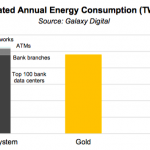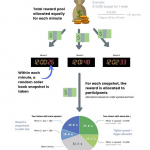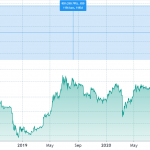“We assembled here today are issuing a new decree to be heard in every city, in every foreign capital, and in every hall of power. From this day forward, a new vision will govern our land… we must think big and dream even bigger…
Do not let anyone tell you it cannot be done. No challenge can match the heart and fight and spirit of America…
We stand at the birth of a new millennium, ready to unlock the mysteries of space, to free the Earth from the miseries of disease, and to harness the energies, industries and technologies of tomorrow…
So to all Americans, in every city near and far, small and large, from mountain to mountain, and from ocean to ocean, hear these words: You will never be ignored again.” President Trump’s promise to the American People at his inaugural address on January 20th 2017.
Chairman, Commissioners, SEC personnel, Ladies and Gentlemen. A new force has risen in the world, code based technological innovation. It promises to transform almost all industries, from village fishing to the towers of banking. Reports say billions will be saved, others stupendously claim trillion dollar industries will be created.
“We are on the brink of yet another industrial revolution. One that has the potential, once again, fundamentally to transform the structure of the global economy, and the way we live our lives.” Philip Hammond, Chancellor of the British Exchequer, at the inaugural International FinTech Conference in London.
As a journalist in this space, I’ve detailed some of these potential transformations. Meet Candy, an IBM blockchain and internet of things (IoT) demo. You can get a sort of online code ticket organized through the blockchain, give it to Candy, which then uses sensors, data analytics, speech recognition, and other advances in computer science, to dispense some candy.
“Towards the end of the Fair there was a girl in her twenties who approached the booth to know what it was all about. She didn’t want sweets, she just wanted to chat. When Candy learned the girl didn’t like sweets, Candy expressed her feelings. “You don’t like candy… so you don’t like me? You make me feel sad, I think I’m going to cry.” Interestingly the girl ended up apologizing for not liking candy and they became friends.”
Igor Ramos, Senior Software Engineer at IBM says: “Although it sounds like science fiction, it isn’t, it’s real and here.” As you might appreciate, this is a demo. It’s not showing a product, but showcasing, in effect, a specialized robot and the tools that built it.
“In view of the devastation caused by Hurricane Sandy in 2012, the project plans to install battery storage units within the grid in order to keep the lights on at least temporarily during the next storm-related emergency.”
That’s what Siemens said when announcing they are working with a new start-up, LO3 Energy, to test energy re-sale from solar powered microgrid through ethereum’s public blockchain. Siemen says the ethereum (eth or ether) blockchain:
“Can ensure that users receive original replacement parts, because it can seamlessly retrace a part’s journey back to its origins with the help of an RFID chip and the blockchain – one of many potentially interesting applications for Siemens.”
There are many other eth based projects which would probably require a book to detail. So perhaps it would be easier to explain just what exactly is ethereum.
Ethereum, The Code
Ethereum uses smart contracts, which is a fancy way of saying code. But it does so in a unique manner. Code is usually held in your own machine, or a server, but for ethereum, the same exact code is held in around 10,000 machines, otherwise known as nodes.
This means no one can change it, making it very useful for record keeping, from energy sale, to health records, to fishing supplies to whatever else you can imagine. One such use of record keeping is a unique code string which is produced through complex cryptographic maths to ensure that you alone have a copy of it. That copy is called one eth or ethereum. It can’t be duplicated, but it can easily move.
The way it moves is through those 10,000 machines which obey the rules of complex open source code. Through cryptomaths, you (or rather a code software called a wallet) tells them you have ten eth and want to send it to Alice, the machine verifies it, and then the eth moves in around 15 seconds with the transaction finalized in a way that can’t be reversed.
The Coded Machines
This is the simple application. A far more interesting application is the fact that code itself, the smart contract, can do the above too, with no human intervention, automatically. You just write a piece of code that lays out the rules of how the code has to use the eth. You then send this code to the 10,000 machines who verify and ensure that it does exactly what you coded and that it uses the eth in exactly the manner you code ordered.
This has two interesting applications. First of all, it allows physical machines, like a car, or some factory machine, to hold eth in a way that no one can steal or make it do something other than what you coded. That is, it allows machines to autonomously act by sending and receiving value in a completely transparent fraud proof manner with no human intervention.
The second interesting application is that it turns static money into dynamic code. In this new world, money doesn’t just move from a to b. Money, instead, can analyze all sorts of data, can use artificial intelligence, can operate under complex rules which it fully obeys, even can run its own business with no or minimal human involvement.
Innovation is happening in many areas, with an interesting one being the use of eth’s public blockchain to act as a glue that joins together the forces of freelancers in a company with no CEOs or Board of Directors as all the freelancers in combination would be the CEO or Board of Directors.
I’ll leave it to your imagination to further wonder how this technology could be used. Suffices to say, almost all household brands, as diverse as JP Morgan and the oil giant BP, have formed an alliance in support of ethereum’s platform.
In this context, hopefully, it won’t take much imagination to see why so many want a piece of this code called eth. The digital currencies market has surpassed $30 billion, a valuation higher than many listed companies. Eth itself is currently valued at $5 billion after just one year. From China to America, Britain and the rest, many see it as the future.
Underlying Utility
Eth, the unduplicable piece of code itself, is used for many projects and applications, such as some we’ve briefly highlighted above. Thus giving it an underlying utility. Moreover, not much different from a stock, its price tends to react dependent on how the network at large is doing.
If utility is increased, say through the announcement of a new project or alliance/consortium, then its price tends to increase, just as stocks would increase if sales increase. Conversely, if its use is lacking or there’s bad news related to the network itself or one of the projects, then price tends to react accordingly.
There is a strong correlation between the number of eth transactions and its price, suggesting that the market, while speculative as all markets, is also acting objectively. In the one year that I have been following ethereum, its price has behaved in an expected manner. Suggesting that there is no manipulation or, if there is any, then it is very limited as otherwise someone would have noticed some discrepancy somewhere.
Most Eth Trading is on Regulated Exchanges
Trading volumes necessarily change up and down, but looking at them at the time of writing, Coinbase, an American regulated exchange, handles most of the eth/usd volume, currently standing at around 105,000 eth per day according to Cryptowatch. Kraken, another eth exchange, handles around 75,000 eth a day. Bitfinex is going through some considerable difficulties due to being shut out of the banking system. Any volume they currently handle (around 65k), therefore, is probably individuals getting out or probably temporary arbitrage.
However, that Bitfinex handles any volume at all is partly, if not largely, the fault of regulators and, in this case, CFTC specifically. They have denied full margins and futures to regulated exchanges such as Coinbase, therefore forcing the market to unregulated exchanges as margins and futures are very much necessary for traders.
Nonetheless, for eth/fiat pairs, the majority of trading by far still happens on regulated exchanges which account for a daily volume of around 200,000 eth with the only other unregulated eth exchange for eth/fiat pairs that has any significant volume besides Bitfinex, is BTC-e which handles only 25,000, around 10%.
This wasn’t always the case because when eth launched the infrastructure wasn’t quite in place (Coinbase added eth around summer 2016). Therefore, most of the trading happened in an unregulated exchange which allows for digital currencies to be traded against bitcoin, rather than fiat currencies such as dollars or euros. That exchange, Poloniex, today accounts for around 40% of eth trading, probably due to inertia and probably because it offers margins.
As ethereum has grown in market cap with a shift in attitude, from eth/btc to eth/usd, occurring sometime last year after Coinbase added eth, the trend has been a movement away from Poloniex (which last year accounted for almost 100% of eth trading) and to other exchanges, primarily Coinbase, but also Kraken.
That trend is likely to continue, especially as now Coinbase has announced they are to offer margins for traders that handle $5 million or more in volume. Overall, therefore, the majority of trading for eth/fiat and a very considerable amount of overall trading occurs on regulated exchanges, making any manipulation very difficult and detectable.
The Public Interest
The second part for which SEC requires comments is “protecting the public.” This is a general, catch-all, subjective phrase that can mean anything. If we are to be objective, Congress’ intention must have been protecting the public from fraud, or some other criminal activity, or deception. It certainly can’t mean protecting the public from volatility or natural risk that comes with all investments, including the fact that all of it can be lost.
Stock listed companies have gone bankrupt. The stock market has crashed. Can ethereum go to zero? It’s possible, in the same way it’s possible America could collapse. However, I’d put the chances of ethereum reaching zero in the foreseeable future at around zero.
The network is literally just code. There may, of course, be difficulties, but code is malleable and easily fixable. We saw, for example, with the Slockit DAO, that around $250 million, as valued at the time, was stolen. However, for the first time in history, this theft was fully prevented by a simple code upgrade.
Hundreds of millions were also stolen from the SWIFT network, but they were unable to fully recover them as far as I can recall from memory. In my view, therefore, ethereum is not so risky for the entire value to be lost.
Of course it’s possible, in the same way it’s possible the sun might not rise or the moon might fall, but if we are to deal with objective matters, such as probabilities, I find it extremely unlikely ethereum would just completely lose value in a very sudden manner. If it ever does, it would probably be a slow and gradual loss of interest by investors who, since they are the ones losing interest, would have notice of it.
That doesn’t mean some bug might not be found, but it’s code. Such bug would most likely be very quickly fixed with the entire event very temporary and perhaps with no effect on the price at all.
I don’t think, however, there can be a bug which basically sends the network down to zero because much of ethereum is conceptual and conceptually it does work and has been working for now almost a decade. It’s an invention, you know airplanes just work or don’t, cars just work. You can’t uninvent them – well, as long as we’re staying within probabilities.
As for volatility, the currency is volatile, but that volatility tends to be upwards on medium to long time frames. Very much similar to stocks which for traders are very volatile as anyone can see by going to wallstreetbets, but in a medium-long time frame tend upwards.
One aspect the SEC might be worried about may be the loss or theft of private keys. As stated earlier, we have already seen such theft successfully resolved, but even if that option was not used, keys are not necessarily easy to lose or steal.
The easy analogy here is to gold. If one drops a neckless then that might be lost. If one’s home is not secured, then it might be stolen. If you are a bank, then of course you’ll use underground vaults with armed guards.
Similarly, one might be reckless with one or two eth. Perhaps they might not very securely hold 100 eth. But for Coinbase, which is to act as custodian for the ETF, I think the measures they take are not very much different from an underground vault with armed guards.
The exchange has never been hacked. It’s two co-founders came from the famous Silicon Valley based Ycombinators, an incubator that is in extremely high demand thus has fierce competition. The exchange was regulated from inception and generally has been very professional.
They are the first port for most who want to buy eth, with the exchange having some ten million accounts if memory serves me well. They also have a service which they do call vault.
Now, of course it is possible they could nonetheless be stolen, but as far as probabilities go I’d put them around the same level as a theft of the Bank of England’s gold. Moreover, if the latter happened, they might be able to get away with it. For eth, as we saw with the Slockit DAO, and although of course it’s not guaranteed, but, eth does, if so designed, have an ultimate fail save mechanism against thefts of huge scale.
The flip side of public interest needs to also be considered. Would the public benefit from new innovative activity that increases productivity while lowering costs? Is it in the interest of the public to reward innovators and encourage entrepreneurs to make productive use of capital so as to increase and encourage growth?
The public, including giant household companies, have clearly a significant interest in this technology and are investing in its ecosystem because they see many benefits. I would, therefore, strongly argue that the public’s interest is served far more by listing, rather than denying, this ETF.
Closing Remarks
The invention of ethereum has opened a new world of opportunities and has energized a new generation which looks forward to building a better world. A generation which, in the case of ethereum, is overall responsible, scientifically minded, politically diverse, pragmatic and grounded.
The monetary uses of this technology are just one aspect with its industrial uses perhaps far more numerous. From supply lines to fancy dresses, social networks to artificial intelligence. Just the applications we can see and are being deployed are so many, let alone what we have not yet thought of.
The innovative work of many in this space, from start-ups to giant tech companies such as IBM and Microsoft, is what makes America, America and is one of the great success stories of this nation.
The SEC, with this ETF application, is being invited to celebrate this great American success story. I’d urge the SEC to do so and to let people dream of a new future and to take part in it. To let them be inspired. To welcome innovation. And to bring optimism to this great nation.
Or they’ll just leave to Britain and other more welcoming jurisdictions while at the same time the best of a new generation concludes that American regulators are standing in the way of innovation for no good reason. A generation which is driving forward the future.
Featured image from Shutterstock.
Advertisement:














